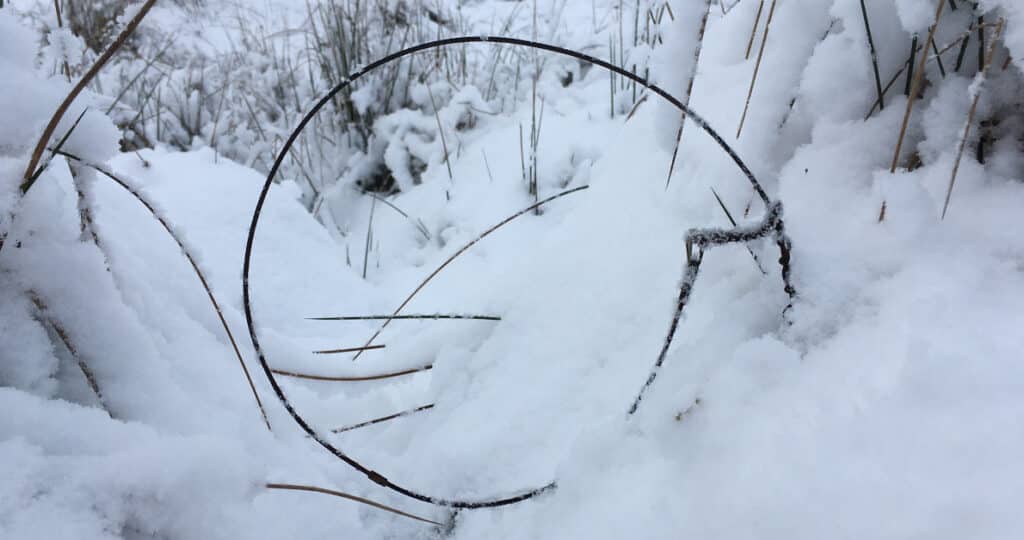Temperatures have dropped significantly in the UK, with many areas seeing thick snow. In these current conditions, you would think that gamekeepers would be deterred from setting fox snares. Unfortunately, wildlife monitors and members of the public are still coming across them.
If an animal is trapped in a snare in sub-zero temperatures, their pain is even more torturous. And so animal rights activists are calling for everyone to monitor their local areas for these nasty pieces of wire.
What, exactly, should you be looking for?
Snares are wire nooses used to restrain foxes, usually on bird-shooting estates. The metal devices hold the fox until someone comes and shoots her. Self-locking snares are illegal in the UK, but the use of free-running snares is still legal, despite being banned in most of Europe. Free-running snares should, in theory, relax if an animal stops struggling, while illegal self-locking snares tighten, and won’t loosen at all.
The National Anti Snaring Campaign (NASC) outlines the types of snares you can find in the UK countryside, and shows you photos of what each snare looks like. The most popular code-compliant snare is the DB snare. The NASC says of this snare:
“This much-touted fox snare was designed by the Game and Wildlife Conservation Trust (GWCT). The snare must incorporate at the eye as its weakest point a ‘break-away’ of appropriate strength to allow the self-release of stronger non-target animals…
The GWCT claim that the fox cable restraint is effective at holding foxes but the included breakaway link allows heavier non-target animals to escape easily… The weak link is supposed to allow a fully grown badger to escape. In reality this is not occurring. No one can pull it apart with gloved hands, so imagine trying to do it with your neck!”

DB snares, aren’t, however, the most popular overall snare in the UK. These are AB snares, which – depending on the type used – can be legal or illegal. NASC says:
“This fox snare does not run as freely as the standard legal types, but does not fully lock either…”
Of course, it’s not only foxes who get trapped in snares. All animals can get caught, including deer, badgers, hedgehogs, rabbits, and family pets. Take Squire the cat, for example. Squire was trapped in a snare almost two months. The images of the metal wrapped around Squire’s body are gruesome. Inverness Cat Rescue’s Heather Swinton Raven told The Sun:
“The vet estimates the snare had been around him for eight weeks and said he was lucky to be alive. If it had got caught it would have just got tighter and tighter where he pulled on it.”
Extreme weather
Protect the Wild spoke to the Hunt Investigation Team (HIT), who are activists on the ground, gathering evidence to expose animal cruelty. HIT told us that the extreme weather makes snares all the more torturous. The team said:
“Imagine if your family cat or dog were caught and trapped in wire outdoors tonight. Not only the immense pain and fear they would feel, but also the freezing conditions and potential hypothermia they could experience. This is the agonising reality for animals caught in snares during winter.”
“Snares cause immense suffering at any time of year but are especially cruel during extreme weather. Animals caught in snares during freezing conditions are at risk of suffering hypothermia in addition to the injuries, fear, distress, dehydration and risk of predation which snares cause routinely.”
“if forecasted weather conditions are likely to cause poor welfare or prevent daily inspection. Excess heat as well as cold/wind/rain/snow, etc. must be considered”,
“Render the snare inoperable if forecasted weather conditions are likely to cause poor welfare or prevent daily inspection.”
“Snare users are not required to register their use, so snare victims are usually unseen and their suffering is unreported.”
Monitor your area
“Shooting estates – grouse, pheasant and partridge – are prime locations, along with some farmland. Please be alert for wildlife persecution in your area this winter.”

